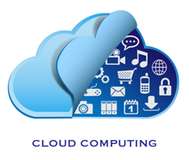 “The Cloud” is one of the hottest phrases in technology these days. Depending on who’s talking it can be uttered with casual ease or genuine awe. It can mean convenience to someone traveling or cost savings to a business owner.
“The Cloud” is one of the hottest phrases in technology these days. Depending on who’s talking it can be uttered with casual ease or genuine awe. It can mean convenience to someone traveling or cost savings to a business owner. Let’s start with what the Cloud is not. It’s not the Internet. You do need the Internet to access the cloud. Not everyone in the world has access to or needs to use the cloud.
Cloud computing refers to the ability of a person to use applications and access data that are stored outside of their device, appliance or desktop computer. It does sound like the web but it’s not the same thing.
Cloud or Web - Which Is It?
Two things differentiate the cloud from the Internet - data storage and application access. Let’s take a task that most people are familiar with - word processing.
If you have a two page formatted letter to create you have 3 options:
1. Use a word processor on your computer like Microsoft Word or Apple’s Pages.
2. Use a word processing app on your smartphone or tablet like Pages or Smart Office.
3. Open a browser on your computer or mobile device to Google Docs or Microsoft Office 360.
In the first and second examples, the document you are working on stays on the machine or device you’re using. You don’t need Internet access to work on your letter. You can edit and save the letter as often as you like.
In the third example, the entire operation of creating, editing and saving the letter is carried out within Google or Microsoft’s servers. These servers (thousands of them) form the cloud architecture.
Your browser accesses the web page. The page links your device to the cloud and displays the word processor program. Every command and key you press travels from your device through the web to the servers. The changes are made in the cloud and your display of the data (your letter) reflects the change. You need Internet access to make changes and save versions of your letter.
Pros and Cons of the Cloud
Having your data and applications in the cloud means that you can access your information at any time and from anywhere. For someone traveling the availability of materials outside of the office is essential and convenient.
It also means that you pay a lower cost to use an application. Users of Google Apps and Microsoft Business 360 pay a small monthly fee to use a suite of applications from word processing to spreadsheets to presentation software. By comparison, installing the full Microsoft Office product on your computer would cost more than one hundred dollars for each user. The annual subscription for either Google or Microsoft’s services is $5 per user per month.
Despite the convenience and cost savings, there are still reasons to be wary of solely using cloud services. The two biggest concerns that cloud users are faced with are data loss and privacy.
If your laptop is damaged and you had no backup of your documents, it could mean that you’ve lost your data with little hope of recreating it. If your data is in the cloud, then your data is intact. Once you’ve replaced your laptop or mobile device, you can use your cloud data and applications as before.
However, should the cloud service provider have problems with their servers, then the data loss will certainly affect you. Fortunately this sort of data loss is not common. Reputable companies will have adequate data backups to protect their users’ data.
Another kind of data loss is loss of access rights to the data. Google Apps and Microsoft 360 are subscription-based. This means that as long as you pay the monthly fees you’ll have access to whatever data you’ve stored on their servers. In the past when you buy a piece of software you retain the rights to that item. With cloud computing you don’t own the software but only have the right to access the free or subscription-based service.
Privacy is becoming a bigger issue. While service providers maintain procedures and rules to ensure your data remains private, they are able to monitor your access to the service and do have your data on their equipment. Ultimately it is up to you to safeguard your data by keeping passwords safe and deleting your data once you no longer use the service.
Get On The Cloud
In a previous article, I had listed five areas of computing - Enterprise Computing, Embedded Systems, Systems Software, Web and Mobile. I’m adding a sixth - Cloud Computing.
It’s not a fluke that the most sought after jobs in recent years were cloud related. As cloud-based services and products mature and evolve, new jobs are being created. Some of these jobs couldn’t have been imagined twenty years ago.
If you’re currently a developer, analyst or designer, think about how your skills can be adapted to cloud computing. It could open new opportunities for you. If you’re in college, a computer science degree is an ideal first step into cloud computing.
Cloud computing is something that once only appeared in science fiction. Now it’s used everyday worldwide. Cloud computing is not a fad. It’s here to stay. It’s a career path that will prove challenging and rewarding for decades to come.


